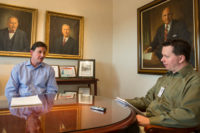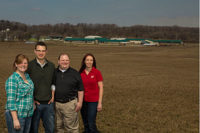Oscar Mayer: Innovation has a first name...
With a tip of the hat to the past, Oscar Mayer reaffirms its desire to innovate with consumers in mind as part of the new Kraft Foods.

Tricia White, vice president, RD&Q, Oscar Mayer; Tom Lopez, vice president, marketing, Kraft Foods; and Randy Glynn, senior R&D engineer, Kraft Foods

Shredded Oscar Mayer Carving Board Pulled Pork product is packed into a transparent tray at the Davenport, Iowa, processing facility, a strategic move that allows consumers to see the quality of the product within the package.

Randy Glynn (left), senior R&D engineer, and Tricia White, vice president, RD&Q, for Oscar Mayer, explain the development of the Carving Board and Selects brands to Andy Hanacek, editor-in-chief of The National Provisioner, in the company’s new Proof of Principle (POP) Room in Madison, Wis.

Andy Hanacek, editor-in-chief of The National Provisioner, sat down with Nick Meriggioli (left), president of Oscar Mayer, to get his thoughts on the brand’s product-development dynasty and where it is heading, in an online-only Q&A on ProvisionerOnline.com: http://bit.ly/103bDVe

Harry Crane, executive chef/culinary group manager; Denise Abts, associate manager culinary; and Jennifer Cuccia, culinary manager, Strategic Technology & Innovation for Kraft Foods, proudly display the versatility of the Oscar Mayer Carving Board Pulled Pork, at the company’s Madison headquarters.

Oscar Mayer Carving Board Pulled Pork packages ride along a conveyor to be case-packed at the company’s Davenport, Iowa, processing facility.

Tom Bick, director, integrated advertising for Oscar Mayer, and Hanacek discuss the modifications to Oscar Mayer’s advertising strategies over the past few years at the Madison headquarters.






Report Abusive Comment